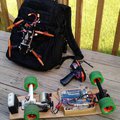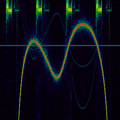Ettus support is fantastic from my experience
 and I don't have any affiliations with them
and I don't have any affiliations with them
 and LimeSDR support has been like super bad, I had a couple bricked Limes early on
and LimeSDR support has been like super bad, I had a couple bricked Limes early on
![]() And part of that: is there a good way to map out the power output as a function of frequency?
And part of that: is there a good way to map out the power output as a function of frequency?
 from my experience
from my experience
 @Aaron a lot of FPGAs include DSP blocks that are good for implementing FIR filters
@Aaron a lot of FPGAs include DSP blocks that are good for implementing FIR filters
 sorry if there are Lime folks here
sorry if there are Lime folks here
 I'll have to look into that NMR app later
I'll have to look into that NMR app later
 hadnt seen it before
hadnt seen it before
 keep in mind, when someone uses a certain SDR for a certain app, 99% of the time they could have used a different SDR
keep in mind, when someone uses a certain SDR for a certain app, 99% of the time they could have used a different SDR
 so it really comes down to being familiar with the API
so it really comes down to being familiar with the API
 and having code examples and such
and having code examples and such
![]() NMR is super useful for my work so it def caught my attention
NMR is super useful for my work so it def caught my attention
![]() looks like there's a range of possibilities with various rf-freq measurement of materials.
looks like there's a range of possibilities with various rf-freq measurement of materials.
 yeah I wouldn't put much emphasis on the LimeSDR part
yeah I wouldn't put much emphasis on the LimeSDR part
 they probably could have used several other SDRs
they probably could have used several other SDRs
![]() Point taken
Point taken
 SDRs are very general purpose
SDRs are very general purpose
![]() Will this chat transcript be available later?
Will this chat transcript be available later?
 @perronemajr - Any idea how old that NMR article is? Might make a good Hackaday writeup if it's still pretty fresh.
@perronemajr - Any idea how old that NMR article is? Might make a good Hackaday writeup if it's still pretty fresh.
 and like I said, the way I usually use them is to deliver the baseband IQ samples to my host machine, where they get processed
and like I said, the way I usually use them is to deliver the baseband IQ samples to my host machine, where they get processed
![]() That's why I asked if there was a good way of mapping the power output
That's why I asked if there was a good way of mapping the power output
 I only rarely modify the FPGA on the SDR itself
I only rarely modify the FPGA on the SDR itself
![]() because if you can map it out for hackrf one then you can use that instead
because if you can map it out for hackrf one then you can use that instead
 @Aaron - Yes, absolutely. I'll post it right after the chat.
@Aaron - Yes, absolutely. I'll post it right after the chat.
 yeah and another SDR uses the same FPGA or RFIC then there's less work to do
yeah and another SDR uses the same FPGA or RFIC then there's less work to do
![]() Great, Thanks! Some of us are still at work.. shhhh... =)
Great, Thanks! Some of us are still at work.. shhhh... =)
![]() Thanks Dan
Thanks Dan
 or if the app didn't involve modifying the FPGA, you can probably sub them out with little effort
or if the app didn't involve modifying the FPGA, you can probably sub them out with little effort
 like if all the DSP is happening on the host machine, its easy to swap SDRs
like if all the DSP is happening on the host machine, its easy to swap SDRs
 the SDR is just a frequency-agile receiver (or transmitter) in that case
the SDR is just a frequency-agile receiver (or transmitter) in that case
![]() I think it did modify the FPGA, according to the paper written
I think it did modify the FPGA, according to the paper written
 yeah
yeah
![]() Will check again though
Will check again though
 so then you would want to check how big an FPGA is needed
so then you would want to check how big an FPGA is needed
![]() And look for ways around
And look for ways around
 like the PlutoSDR has almost no room left on the FPGA for custom stuff
like the PlutoSDR has almost no room left on the FPGA for custom stuff
 but USRP B210 I think has a lot of room
but USRP B210 I think has a lot of room
 not sure about HackRF
not sure about HackRF
 bigger FPGAs cost a lot more
bigger FPGAs cost a lot more
 so when you see more expensive SDRs, that might be one reason, larger FPGA
so when you see more expensive SDRs, that might be one reason, larger FPGA
 I like to do my DSP on the host side, for the sake of rapid development
I like to do my DSP on the host side, for the sake of rapid development
 but if you need to do some DSP at "high rate", sometimes it has to be done on the FPGA
but if you need to do some DSP at "high rate", sometimes it has to be done on the FPGA
![]() What's a good budget SDR with an FPGA at least as large as the one lime has?
What's a good budget SDR with an FPGA at least as large as the one lime has?
 using GNU Radio, I swap between USRP B200mini and a Pluto with almost zero effort for transmit and receive
using GNU Radio, I swap between USRP B200mini and a Pluto with almost zero effort for transmit and receive
 yeah GNU Radio is all about doing DSP on the host, until you get into RFNoC
yeah GNU Radio is all about doing DSP on the host, until you get into RFNoC
 I dont know exactly how large the Lime's is, but considering the price its probably on the smaller end
I dont know exactly how large the Lime's is, but considering the price its probably on the smaller end
 you can see how many LUTs or however they measure the size of the FPGA
you can see how many LUTs or however they measure the size of the FPGA
 its an Intel, not Xilinx, so might be harder to compare, not sure
its an Intel, not Xilinx, so might be harder to compare, not sure
![]() Wikipedia is great: https://en.wikipedia.org/wiki/List_of_software-defined_radios checking now
Wikipedia is great: https://en.wikipedia.org/wiki/List_of_software-defined_radios checking now
 FPGA development is like a whole other thing =P
FPGA development is like a whole other thing =P
 lots of jobs out there for FPGA devs, if any students are in the chat
lots of jobs out there for FPGA devs, if any students are in the chat
 Makes me want to ask, the BladeRF Micro has two choices between 40k and 300k LEs. Any idea what kind of applications would require the much larger chip?
Makes me want to ask, the BladeRF Micro has two choices between 40k and 300k LEs. Any idea what kind of applications would require the much larger chip?
 Have you tried the pynq board for python to fpga?
Have you tried the pynq board for python to fpga?
 get good with FPGA dev, and learn DSP basics (eg with www.pysdr.org) and you'll have a lot of opportunities
get good with FPGA dev, and learn DSP basics (eg with www.pysdr.org) and you'll have a lot of opportunities
 40k already "feels" like a lot but I imagine the DSP gets very heavy on resource usage
40k already "feels" like a lot but I imagine the DSP gets very heavy on resource usage
![]() Doesn't list one for hackrf; perhaps it doesn't have one? Or maybe it's just very small
Doesn't list one for hackrf; perhaps it doesn't have one? Or maybe it's just very small
 any app that requires a lot of DSP on the FPGA will need the larger one. The smaller one has just enough room for the existing code, I believe, it's not intended to add much to
any app that requires a lot of DSP on the FPGA will need the larger one. The smaller one has just enough room for the existing code, I believe, it's not intended to add much to
 the HackRF just has a very small CPLD for glue logic, no FPGA
the HackRF just has a very small CPLD for glue logic, no FPGA
 oh ok
oh ok
 yeah I mean most of the apps I made did not involve adding to the FPGA
yeah I mean most of the apps I made did not involve adding to the FPGA
 I always prefer not to do FPGA dev, unless its necessary
I always prefer not to do FPGA dev, unless its necessary
 in fact i like to stay within Python, where most folks use C/C++ for SDR apps
in fact i like to stay within Python, where most folks use C/C++ for SDR apps
 so I prefer SDRs with good Python APIs, which most have
so I prefer SDRs with good Python APIs, which most have
 usually the heavy lifting it done in C, and they use pybind or something for the Python API
usually the heavy lifting it done in C, and they use pybind or something for the Python API
 so dont think you are going to have a huge performance hit by using Python for your SDR app
so dont think you are going to have a huge performance hit by using Python for your SDR app
 like most numpy functions are implemented in C, and very performant
like most numpy functions are implemented in C, and very performant
![]() It will depend on the device installed on.
It will depend on the device installed on.
 RE "40k already "feels" like a lot but I imagine the DSP gets very heavy on resource usage" dont forget about everything the company had to add
RE "40k already "feels" like a lot but I imagine the DSP gets very heavy on resource usage" dont forget about everything the company had to add
 yeah for sure
yeah for sure
![]() I tried using the Raspberry Pi, it was SLOW..
I tried using the Raspberry Pi, it was SLOW..
 yeah I like to use x86 platforms whenever I can, for rapid development sake
yeah I like to use x86 platforms whenever I can, for rapid development sake
![]() rpi 3 or 4?
rpi 3 or 4?
 Ive been enjoying using these x86 based single board computers that have either Atoms or full Core CPUs on them
Ive been enjoying using these x86 based single board computers that have either Atoms or full Core CPUs on them
![]() Could the DSP be moved to the computer instead of FPGA? for NMR or EPR real time isn't needed; just needs to scan through the frequencies
Could the DSP be moved to the computer instead of FPGA? for NMR or EPR real time isn't needed; just needs to scan through the frequencies
 About Pi I was jsut on that page: The SDR Linux Distro for Raspberry Pi https://pisdr.luigi.ltd/
About Pi I was jsut on that page: The SDR Linux Distro for Raspberry Pi https://pisdr.luigi.ltd/
 "Could the DSP be moved to the computer instead of FPGA" Always!!!!
"Could the DSP be moved to the computer instead of FPGA" Always!!!!
 just depends how many samples you want to pump through
just depends how many samples you want to pump through
![]() Well that's encouraging: I'll take a look
Well that's encouraging: I'll take a look
 a given realtime app can usually be performed near-realtime by using CPU instead of FPGA
a given realtime app can usually be performed near-realtime by using CPU instead of FPGA
 I can do the basic GNU Radio stuff on an rPi, but it can be overloaded with higher sample rates
I can do the basic GNU Radio stuff on an rPi, but it can be overloaded with higher sample rates
![]() I started making an SDR image for the PI.. Great idea! I would love to try someone elses..
I started making an SDR image for the PI.. Great idea! I would love to try someone elses..
 and i would recommend that if you're a hobbyist, you can always port the functionality to the FPGA later
and i would recommend that if you're a hobbyist, you can always port the functionality to the FPGA later
 I've done stuff on the Pi, but I usually do the development on a powerful machine, then make sure it can run fast enough on the Pi
I've done stuff on the Pi, but I usually do the development on a powerful machine, then make sure it can run fast enough on the Pi
 its just more rapid development that way
its just more rapid development that way
![]() True..
True..

 well you'll need to learn FPGA development
well you'll need to learn FPGA development
 so might want to start with a dev kit for whatever ecosystem you plan to use (e.g. Vivado)
so might want to start with a dev kit for whatever ecosystem you plan to use (e.g. Vivado)
 like an Artix based board, which can be had for less than $100
like an Artix based board, which can be had for less than $100
![]() Plus there are several companies. You have to stick with the one that has the most for your application.
Plus there are several companies. You have to stick with the one that has the most for your application.
 you can use the free Vivado license if your FPGA is small enough
you can use the free Vivado license if your FPGA is small enough
 yeah figure out which FPGA you will have to target
yeah figure out which FPGA you will have to target
![]() Like Altera, I use them, but xilinx has some features that seem better for certain applications.
Like Altera, I use them, but xilinx has some features that seem better for certain applications.
 like switching from Xilinx to Intel is unlike any other switch I can think of
like switching from Xilinx to Intel is unlike any other switch I can think of
 Intel/Altera
Intel/Altera
![]() I am excited they bought Altera..
I am excited they bought Altera..
 During remoticon I set up the PiSDR on a RasPi3 and it runs nicely.
During remoticon I set up the PiSDR on a RasPi3 and it runs nicely.
 yeah same
yeah same
![]() I can't wait to try GNU Radio on the pi 4..
I can't wait to try GNU Radio on the pi 4..
 in the SDR world, Xilinx has been the dominant force
in the SDR world, Xilinx has been the dominant force
 as well as US gov
as well as US gov
 AMD recently bought xilnix
AMD recently bought xilnix
 the SDRs that use Intel/Altera did it to save money =P
the SDRs that use Intel/Altera did it to save money =P
 yeah AMD has been insane lately
yeah AMD has been insane lately
![]() Gnu radio + rpi4 = personal space heater
Gnu radio + rpi4 = personal space heater
 they are crushing it on all fronts
they are crushing it on all fronts
 for a pre-built ISO image for GNU Radio for rPi, look at https://github.com/luigifcruz/pisdr-image
for a pre-built ISO image for GNU Radio for rPi, look at https://github.com/luigifcruz/pisdr-image
![]() You also have to make sure your FPGA dev board has enought memory for what you need to do.
You also have to make sure your FPGA dev board has enought memory for what you need to do.
![]() Thanks Barry.. I am going to try that!
Thanks Barry.. I am going to try that!
 The AMD CEO knows what she is doing.
The AMD CEO knows what she is doing.
 from a branding perspective, Altera switched to Intel, but I doubt Xilinx will switch their branding
from a branding perspective, Altera switched to Intel, but I doubt Xilinx will switch their branding
 I think it was because Altera was losing the race and Intel had always been a big name
I think it was because Altera was losing the race and Intel had always been a big name
![]() what about synchronization of multiple receivers? antenna arrays, time-of-arrival passive radars...?
what about synchronization of multiple receivers? antenna arrays, time-of-arrival passive radars...?
 well when I suggested FPGA dev board, that was purely for learning FPGA dev
well when I suggested FPGA dev board, that was purely for learning FPGA dev
 @kiggins.chris :-D That's the reason I have a fan on the RasPi3.
@kiggins.chris :-D That's the reason I have a fan on the RasPi3.

 i wouldnt get too caught up in the capabilities of the dev board, since you will likely be switching to the FPGA onboard your SDR
i wouldnt get too caught up in the capabilities of the dev board, since you will likely be switching to the FPGA onboard your SDR
 "what about synchronization of multiple receivers? antenna arrays, time-of-arrival passive radars...?" yeah thats an important consideration
"what about synchronization of multiple receivers? antenna arrays, time-of-arrival passive radars...?" yeah thats an important consideration
 Aaron: it also has some other good apps with it
Aaron: it also has some other good apps with it
 I've done work using USRP X310's that were synced over PPS/10MHz, and also work with SDRs synced over GPS
I've done work using USRP X310's that were synced over PPS/10MHz, and also work with SDRs synced over GPS
 I don't have tips for implementing DSP in HDL =P
I don't have tips for implementing DSP in HDL =P
 learn DSP from a conceptual/algorithmic POV
learn DSP from a conceptual/algorithmic POV
 then also get good with FPGA dev
then also get good with FPGA dev
 When you start talking about getting multiple coherent channels using SDRs, you get into the more expensive SDRs (unless you just need 2 channels which the B210 can do)
When you start talking about getting multiple coherent channels using SDRs, you get into the more expensive SDRs (unless you just need 2 channels which the B210 can do)
 and that coherency is required for angle-of-arrival and phased arrays
and that coherency is required for angle-of-arrival and phased arrays
![]() What types of AI/ML techniques or algorithms have you implemented in SDR? What kind of benefits/improvements do they provide?
What types of AI/ML techniques or algorithms have you implemented in SDR? What kind of benefits/improvements do they provide?
 I've done quite a bit of ML apps, but they were always implemented at the host side
I've done quite a bit of ML apps, but they were always implemented at the host side
 since the ML tends to happen at the end of the chain, after any DSP preprocessing and such
since the ML tends to happen at the end of the chain, after any DSP preprocessing and such
![]() can a syncing signal be added to the input signals and then numerically isolated?
can a syncing signal be added to the input signals and then numerically isolated?
 I mean folks have implemented stuff like DNN inference into FPGAs
I mean folks have implemented stuff like DNN inference into FPGAs
 well even with a syncing signal you still need coherent receivers
well even with a syncing signal you still need coherent receivers
 the sync signal will fix any constant phase shift that might exist
the sync signal will fix any constant phase shift that might exist
 but the sync signal is usually over a wire, right?
but the sync signal is usually over a wire, right?
![]() Are SDR outputs delicate to reflected waves? for NMR you basically need to put the transmitter and reciever in a Faraday cage together which means the amplitudes can get pretty high
Are SDR outputs delicate to reflected waves? for NMR you basically need to put the transmitter and reciever in a Faraday cage together which means the amplitudes can get pretty high
 because otherwise it might reach the two apertures at different times
because otherwise it might reach the two apertures at different times
 "Are SDR outputs delicate to reflected waves" yes!!! make sure if you are transmitting, you use a well-matched antenna
"Are SDR outputs delicate to reflected waves" yes!!! make sure if you are transmitting, you use a well-matched antenna
![]() Is it possible to use the reciever as a sink for the energy?
Is it possible to use the reciever as a sink for the energy?
 oh but in a faraday cage your reflections shouldnt be that high
oh but in a faraday cage your reflections shouldnt be that high
 hmm good question
hmm good question
![]() can be wire, can be laser, can be separate radio channel, can be third-party transmitter, can be something gps-derived...
can be wire, can be laser, can be separate radio channel, can be third-party transmitter, can be something gps-derived...
 if you end up receiving at too high a level, just stick an attenutator on the rx port
if you end up receiving at too high a level, just stick an attenutator on the rx port
![]() in faraday cage the reflections can be sky-high. see microwave oven. but it could be lined by a rf absorber.
in faraday cage the reflections can be sky-high. see microwave oven. but it could be lined by a rf absorber.
![]() ^
^
 but high compared to a poorly matched antenna that reflects half the power back?
but high compared to a poorly matched antenna that reflects half the power back?
![]() You'd basically be getting all the power back
You'd basically be getting all the power back
 I guess im confusing rx and tx sides of the SDR which have different hardware
I guess im confusing rx and tx sides of the SDR which have different hardware
 oh geez, yeah def add an attenuator to the rx side then
oh geez, yeah def add an attenuator to the rx side then
![]() Especially in NMR where you're resonating the material
Especially in NMR where you're resonating the material
 Transmitter / receiver switching for NMR is a solved problem.
Transmitter / receiver switching for NMR is a solved problem.
 the SDR data sheets usually have a max input on the RF connector in dBm
the SDR data sheets usually have a max input on the RF connector in dBm
![]() Got it; attenuator was the search term I needed
Got it; attenuator was the search term I needed

![]() what about radar? something pretty cool could be pinging the moon.
what about radar? something pretty cool could be pinging the moon.
 designing an SDR, or SDR app?
designing an SDR, or SDR app?
 also did that NMR app include an added T/R switch?
also did that NMR app include an added T/R switch?
 or did they just use the TX and RX ports separately
or did they just use the TX and RX ports separately

 if you are interested in designing an SDR itself, I would join whatever the largest open source hardware project is
if you are interested in designing an SDR itself, I would join whatever the largest open source hardware project is
 it's an enormous task
it's an enormous task
![]() @Thomas Shaddack https://www.technologyreview.com/2019/08/23/75512/quantum-radar-has-been-demonstrated-for-the-first-time/ cool stuff, don't know why they mentioned it considering certain things...
@Thomas Shaddack https://www.technologyreview.com/2019/08/23/75512/quantum-radar-has-been-demonstrated-for-the-first-time/ cool stuff, don't know why they mentioned it considering certain things...
 what if you just shit out PCBs like its no thing ?
what if you just shit out PCBs like its no thing ?
![]() Yet, china sells the chips for pennies... LOL
Yet, china sells the chips for pennies... LOL
 anyone know what the biggest open hardware SDR project is?
anyone know what the biggest open hardware SDR project is?
![]() That's why I mentioned squeezed states
That's why I mentioned squeezed states
 yeah if you just want an SDR, buy one, lol
yeah if you just want an SDR, buy one, lol
 With NMR there is typically only one coil for transmit and receive.
With NMR there is typically only one coil for transmit and receive.
 but I would avoid the chinese clones if it's your first SDR
but I would avoid the chinese clones if it's your first SDR
![]() Agreed... What is the larges SDR open source project?
Agreed... What is the larges SDR open source project?
 for learning DSP, and how to use SDRs, definitely start with the RX side
for learning DSP, and how to use SDRs, definitely start with the RX side
 now keep in mind, stuff like USRPs have their schematics publicly available, and firmware is open source
now keep in mind, stuff like USRPs have their schematics publicly available, and firmware is open source
![]() Besides GNU radio?
Besides GNU radio?
 well GNU Radio is the software/DSP/GUI side of the SDR app
well GNU Radio is the software/DSP/GUI side of the SDR app
![]() @Jeffrey Forbes Seems to be, just wasn't aware of that stuff, being more in physics than electrical eng.
@Jeffrey Forbes Seems to be, just wasn't aware of that stuff, being more in physics than electrical eng.
 For DSP? Or for hardware?
For DSP? Or for hardware?
 Anyone looked at HPSDR?
Anyone looked at HPSDR?
 GNU Radio competitors include Pothos(sp?) and maybe Red Hawk
GNU Radio competitors include Pothos(sp?) and maybe Red Hawk
 but you don't need a framework like GNU Radio to create an SDR app
but you don't need a framework like GNU Radio to create an SDR app
 GNU Radio just makes it easier to re-use other people's work, and share your work
GNU Radio just makes it easier to re-use other people's work, and share your work
![]() HackRF is open source...
HackRF is open source...
 so you dont have to reinvent the wheel
so you dont have to reinvent the wheel
 yeah but it's still company-driven right
yeah but it's still company-driven right
 are there any community lead ones?
are there any community lead ones?
 I wanted to do one around the AD9375
I wanted to do one around the AD9375
 I guess the short answer is, I wouldn't waste time designing/building an SDR unless that's what you are passionate about
I guess the short answer is, I wouldn't waste time designing/building an SDR unless that's what you are passionate about
 the board design wouldn't be that challenging for me
the board design wouldn't be that challenging for me
![]() @Whitney Knitter def start with rx because accidentally transmitting in bands reserved for military applications gets ugly fast
@Whitney Knitter def start with rx because accidentally transmitting in bands reserved for military applications gets ugly fast
![]() Do you have answers for this? Or asking if we know? *waiting for the answer impatiently..*
Do you have answers for this? Or asking if we know? *waiting for the answer impatiently..*
 keep in mind, a big part of the SDR is its firmware/driver
keep in mind, a big part of the SDR is its firmware/driver
 which question?
which question?
 "What is the larges SDR open source project?"?
"What is the larges SDR open source project?"?
![]() yes
yes
 it's too vague a question imo, depends which side you're talking about
it's too vague a question imo, depends which side you're talking about
![]() @Jeffrey Forbes Interesting how is that done with tx and rx? Just measure the resonance somehow?
@Jeffrey Forbes Interesting how is that done with tx and rx? Just measure the resonance somehow?
![]()
 Dan Maloney
Dan Maloney
Discussions
Become a Hackaday.io Member
Create an account to leave a comment. Already have an account? Log In.